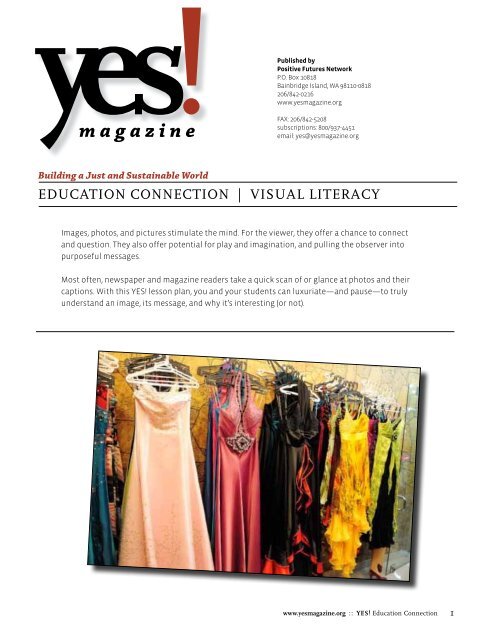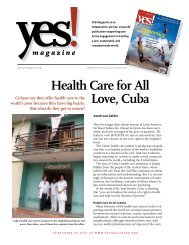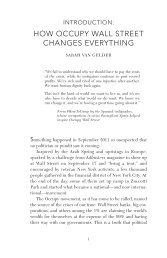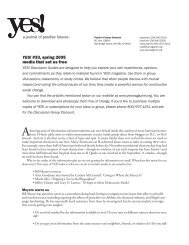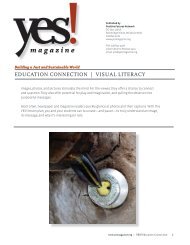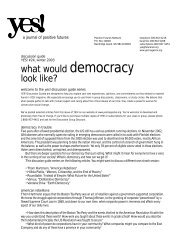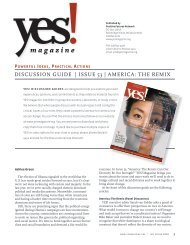Download this lesson plan as a PDF - YES! Magazine
Download this lesson plan as a PDF - YES! Magazine
Download this lesson plan as a PDF - YES! Magazine
You also want an ePaper? Increase the reach of your titles
YUMPU automatically turns print PDFs into web optimized ePapers that Google loves.
yes!<br />
m a g a z i n e<br />
Published by<br />
Positive Futures Network<br />
P.O. Box 10818<br />
Bainbridge Island, WA 98110-0818<br />
206/842-0216<br />
www.yesmagazine.org<br />
FAX: 206/842-5208<br />
subscriptions: 800/937-4451<br />
email: yes@yesmagazine.org<br />
Building a Just and Sustainable World<br />
EDUCATION CONNECTION | VISUAL LITERACY<br />
Images, photos, and pictures stimulate the mind. For the viewer, they offer a chance to connect<br />
and question. They also offer potential for play and imagination, and pulling the observer into<br />
purposeful messages.<br />
Most often, newspaper and magazine readers take a quick scan of or glance at photos and their<br />
captions. With <strong>this</strong> <strong>YES</strong>! <strong>lesson</strong> <strong>plan</strong>, you and your students can luxuriate—and pause—to truly<br />
understand an image, its message, and why it’s interesting (or not).<br />
www.yesmagazine.org :: <strong>YES</strong>! Education Connection 1
yes!<br />
m a g a z i n e<br />
EDUCATION CONNECTION | VISUAL LITERACY<br />
Step One: What do you notice? (before the facts)<br />
Ask your students to make sense of the photograph<br />
by trusting their instincts of observation and inference.<br />
In doing so, the photograph offers possibilities and<br />
interpretations beyond a typical reading where the reader<br />
glances at the picture to reinforce their interpretation of<br />
the picture’s title or caption. Do not introduce any facts,<br />
captions, or other written words outside of the image. You<br />
may hear: fancy dresses, bright colors, hangers, ruffles.<br />
Step Two: What are you wondering? (thinking<br />
about the facts)<br />
After you’ve heard what your students are noticing, you’ll<br />
probably hear the peppering of questions (Where is <strong>this</strong>?<br />
Who will wear these? Are these prom dresses?). That’s<br />
curiosity or wonder—the intermixing of observations<br />
and questions. This is a good time to reveal the photo’s<br />
caption, accompanying quote, and facts about the actual<br />
situation. Watch how the conversation shifts from what<br />
they believe to be true to discerning the facts about the<br />
photo.<br />
Photo caption:<br />
“Women may have to be covered up in public but<br />
what they wear in private is a different story!” Photo by<br />
Abdi Sami, from “Eighteen Days in Tehran” photo essay.<br />
Photo facts:<br />
This photo is part of a slide show that photographer<br />
Abdi Sami created after a recent trip to Iran. He says<br />
about his trip: “Having watched the post-election turmoil<br />
in Iran on television, I wondered what it would be like to<br />
walk the streets and talk to young people. In Tehran, one<br />
witnesses contradictions in everyday life: the opposites<br />
of modern versus traditional, religious versus secular.<br />
[...] The youth are the future of Iran. Most of them were<br />
not born before the Islamic Revolution of 1979. They<br />
see their future not b<strong>as</strong>ed on the values of the p<strong>as</strong>t, but<br />
b<strong>as</strong>ed on how they envision their future.”<br />
Of Iran’s 70 million people, well over half are under the<br />
age of 30.<br />
The word hijab literally means curtain or cover in<br />
Arabic, and is often used to refer to the Islamic dress<br />
code of modesty, while also referring to the headscarves<br />
or covering worn by women to comply with the code. In<br />
religious states, such <strong>as</strong> Iran and Saudi Arabia, covering<br />
up outside of the home is enforced by religious police.<br />
Step Three: What next? (jumping off the facts)<br />
Learning more about a photo leads to bigger questions and<br />
an opportunity to discuss broader issues and perspectives.<br />
• In what ways does our society have similar rules<br />
about “modest dress?” Are there items you are not<br />
permitted to wear in public or at school? Why?<br />
• Just <strong>as</strong> you may have been surprised by what<br />
Muslim women may and may not wear, share a<br />
story where you learned something surprising and<br />
unexpected about a new place or culture.<br />
• Rick Steves calls travel a “political act” because<br />
it inspires creative, new solutions to persistent<br />
problems facing our nation. Have you ever<br />
experienced <strong>this</strong> connection or “aha” moment<br />
where you’ve seen a different or better way of<br />
doing things?<br />
• What do you know about the picture people in<br />
other countries have of Americans? How realistic<br />
is that image?<br />
More resources around the image<br />
SEE: the complete photo essay at<br />
www.yesmagazine.org/peace-justice/eighteen-days-in-tehran<br />
READ: an excerpt from Rick Steves’ Travel <strong>as</strong> a Political Act<br />
www.travel<strong>as</strong>apoliticalact.com/excerpts/understand-iran.html<br />
LEARN: How Not to Travel Like a Tourist<br />
www.yesmagazine.org/issues/latin-america-rising/5-ways-not-to-travel<br />
Thank you to educator Barry Hoonan for contributing to and<br />
shaping <strong>this</strong> <strong>lesson</strong>.<br />
2 <strong>YES</strong>! Education Connection :: www.yesmagazine.org


